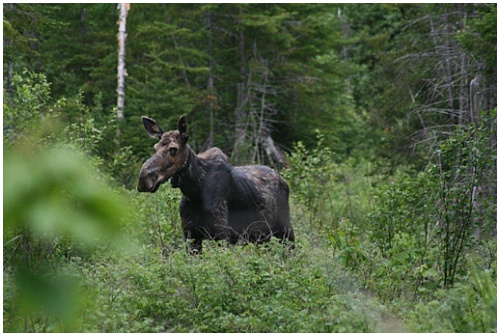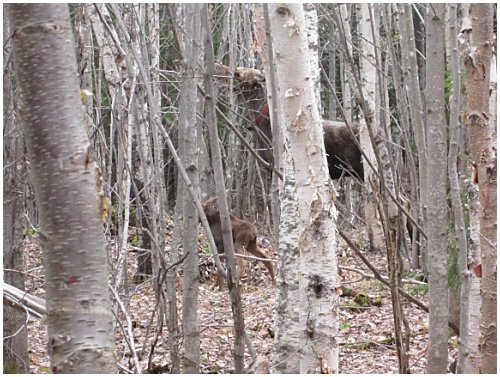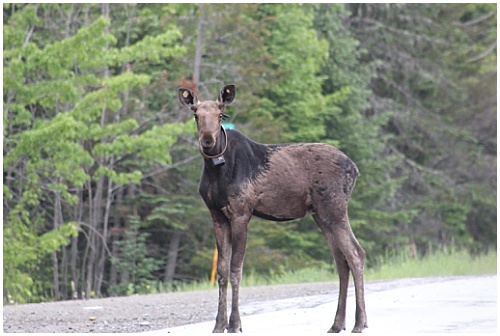ArrayAugust 6, 2020 at 1:25 pm
Year round, Maine Department of Inland Fisheries and Wildlife biologists are going above via helicopters and beyond on ATVs, boats, snowmobiles and foot to implement several adaptive methods of population monitoring for Maine’s beloved and iconic mammal, the moose. Like we predict our changing seasons, data collection methods also change, providing moose biologist Lee Kantar with invaluable information to safeguard the future of the Maine’s moose population.

May – early August: This August, wildlife technicians finished the seventh and final year of cow and calf walk-ins. From early May to early August, these wildlife technicians used their stealthiest skills to sneak up on GPS collared cows to determine whether they have a calf in tow, never had a calf, or had a calf and lost it (mortality). This provides vital insight on how many GPS collared cows birthed calves in a season, as well as how many of those calves survived into August. The first three weeks of life is difficult for a calf and can often end quickly for an underweight or underdeveloped calf, making these walk-ins the surefire way to monitor the earliest stages of survival for these moose calves.

September – October: As the leaves begin to change color in September and October, hunters set out on days (after sometimes months of scouting) of hard work and the chance to secure hundreds of pounds of meat in Maine’s northern and western woods. Hunting game like moose is a productive way to manage a population that might otherwise experience unwanted growth; exceeding the environments ability to sustain too many individuals without leading to starvation, disease and death. Hunting is regulated to ensure the moose population is stable for the future.
When hunters harvest a moose, they are required to drive it to a tagging station where a biologist or other trained representative awaits to collect vital data.
- A tooth is collected to determine the age of the moose. Though antler and body size can provide some insight to the age of a moose, counting the number of growth layers (annuli) in the cementum of teeth, like counting rings in a tree trunk, provides the most accurate method of aging a moose.
- If the moose is harvested in late October, a tick count will be done by an awaiting biologist to contribute valued data for the tick study.
- Additionally, if a hunter was granted a cow permit, that hunter is expected to bring the cow’s ovaries which provide biologists with reproductive data that may reflect the physical condition of the herd and give a clearer image of whether the habitat is ideal enough to support the herd. Idyllic management of moose is dependent in part on age-specific data on body condition, giving birth, and mortality. Thus, age and size offer insight to the likelihood of a female reproducing and whether she has a single calf or twins, providing a projection of the population’s stability. Ideally, mortality balancing with births.
December – mid-February: As falling leaves turn into falling snow, Lee and regional biologists, Kendall Marden and Scott McLellan, gear up with Chris Blackie and Lincoln Mazzei, Forest Ranger Pilots of the Maine Forest Service to begin their annual aerial count surveys from late December to mid-February. With snow on the ground in western and northern Maine, it is an ideal backdrop to spot moose from a helicopter. Counting moose across the entire state is impractical and expensive, so the helicopter flies over specific sections in districts that best represent Maine’s core moose range and habitat. In one survey, biologists count the number of moose spotted, providing an idea of the general number of moose in the core range. On another day, the crew also conducts aerial surveys, looking at the sex and age of individual moose that are spotted from the chopper. Understanding the age and sex composition of a population tells us the number of bulls, cows, and calves in that particular management district, and provides a clear understanding of the number of calves that cows have going into the later part of the winter.
Mid-January: Come mid-January, biologists continue their days in the sky, but with a little more interaction with moose. MDIFW hires Native Range Wildlife Capture Services to net gun and GPS collar moose by helicopter; this was seventh and final with 130 individuals collared in just one week. This year, only calves were collared where years prior, cows were collared as well. These are the collared moose that are mentioned above, during the walk-ins, providing two GPS points per day. Once a calf is spotted, these sky cowboys use a net gun to capture the moose and quickly land the helicopter. Within 10 minutes, the calf is gently tied, provided an eye mask to calm it down, weighed, collared and released. This data provides biologists a starting point for the calf’s health and the collar allows daily monitoring of movement. Tracking movement is key to understanding habitat use and seasonal movements. GPS collars are specifically designed to send out a mortality signal if the moose hasn’t move for more than four hours.
Late February – April: The most physically and mentally challenging season for moose and biologists alike is from late February to April, a time of the year when we experience the most moose deaths across the state. When a moose has died, its collar sends out a mortality signal, and within 24-36 hours, a biologist rushes to the carcass before it can be consumed by scavengers, often traveling miles into the woods. Though the death of a moose is never wanted, the information a carcass tells us is vital for understanding the primary causes of its death.
In recent years, the collaring effort, paired with necropsies (autopsy on an animal), has made it clear that winter ticks are the primary driver in calf death in the state of Maine. Unlike deer ticks, winter ticks do not spread disease. The problem is that they attach by the thousands and stay attached for five or six months, causing moose to experience life-threatening blood loss, hair loss, and even behavioral change. The winter is considered the “second hurdle for calves” as calf survival through the first winter is low, but after they make it through the first winter they have a much better chance of survival. While adult moose experience winter tick challenges throughout the winter months, the magnitude of a calf enduring blood loss from winter ticks is far more severe and leads to the majority of mortalities that occur in March and April.
Each one of these “study” seasons is best represented as a puzzle piece, with little meaning by itself. However, when pieced together, the puzzle becomes a clearer image of proper management for our state’s moose population. Biologists invest a great deal of time implementing creative methods to collect vital pieces of the puzzle. Understanding mortality and survival rates, reproduction, population size and composition pieces together the puzzle to form a picture of the current state of our moose population. With changes in these elements over time, sometimes this can become more challenging to solve, however biologists are constantly searching for answers and ways to ensure the future conservation and health of Maine’s moose.

For more information about Maine’s moose population, the Department’s ongoing moose management study, and winter tick visit mefishwildlife.com/wintertick